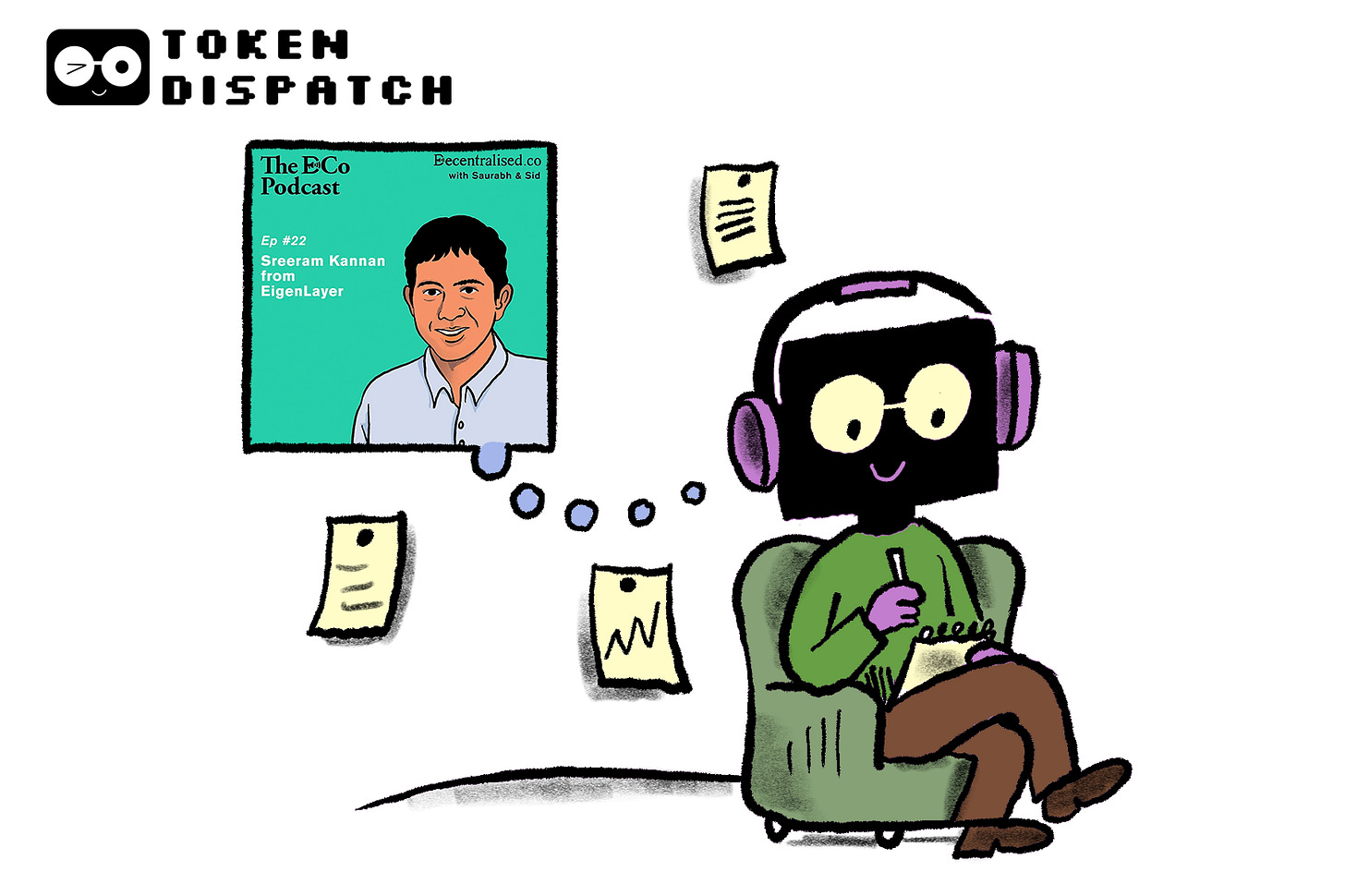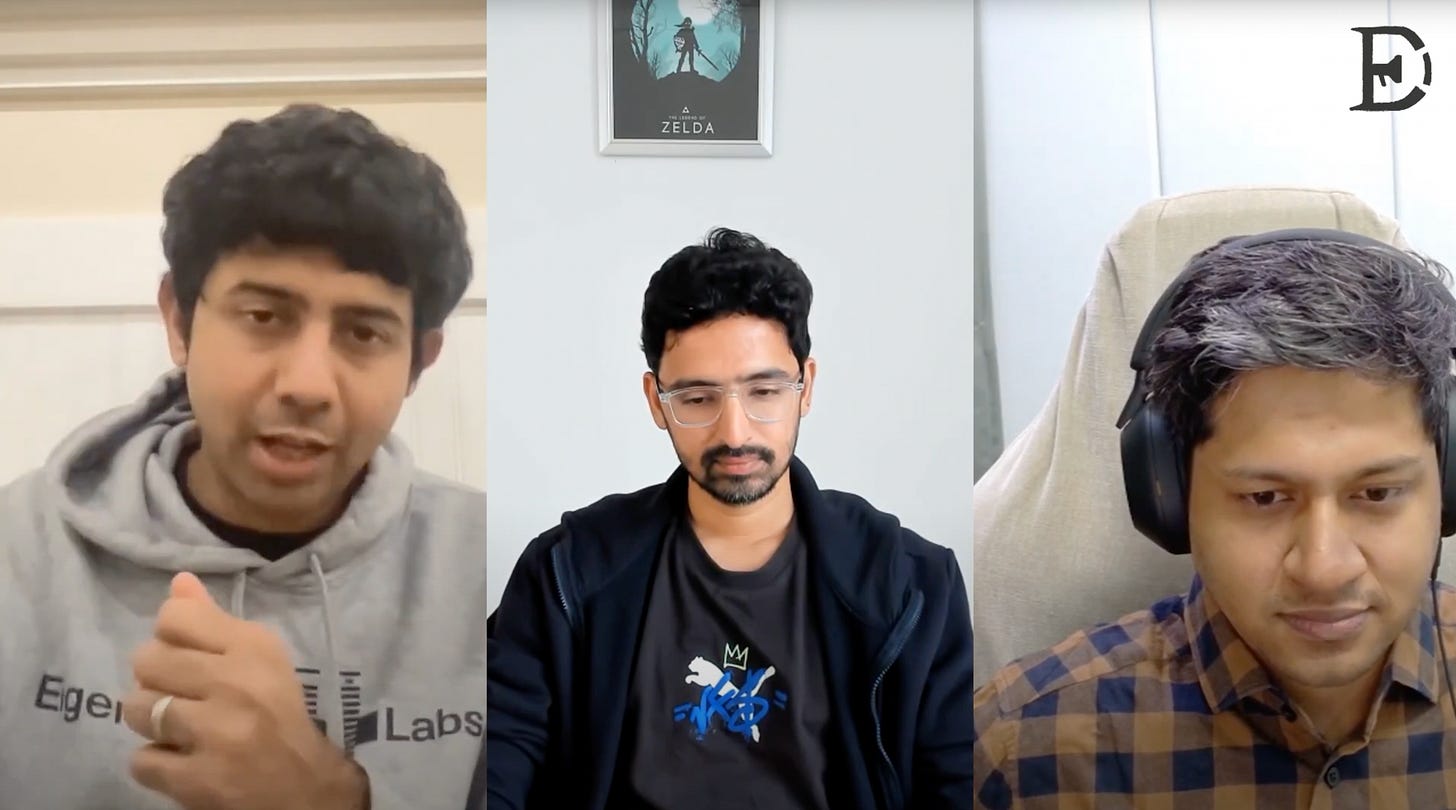Hello,
Every week, I make it a point to tune into the DCo Podcast hosted by Saurabh Deshpande for our partners at Decentralised.co. As part of this weekly ritual, I listen to builders solving problems in Web3, then share my insights with our readers at Token Dispatch.
This week, I write about what EigenLayer founder Sreeram Kannan’s “commitment layer” idea made me realise about the promises we make, and the ones we can’t break.
Want to know that one question that flipped Sreeram’s thinking toward innovation? It’s in the episode. Give it a watch. 👇🏾
Unlock Web3 Insights with Decentralised.co
Long-form stories trusted by the best in Web3. Senior executives from 140+ enterprises trust them to keep them updated on what’s going on in crypto.
Good writing. In-depth conversations. Right in your inbox.
Subscribe to Decentralised.co
I have broken more promises to myself than I’d like to admit: sleeping on time, reducing late-night screen time, and buying a bit of Ether every month to dollar-cost average my crypto portfolio. I genuinely intended to keep all of these promises. Yet, I often slip. The problem is not really the failure but how easily accountability slips through our fingers. We make a promise to ourselves on a good day, break it on a tired one, and justify it by telling ourselves, ‘after all, I’m only human.’ The world moves on, and so do we.
Listening to Sreeram Kannan made me reflect on that gap between saying and doing. He said: “The internet helped us communicate. Crypto helps us commit.”
For thirty years, the internet has made it effortless to say things. We tweet, tag, like, and comment from anywhere. But it never made it any easier to keep our word.
Platforms can promise privacy and then change their stance with each “Policy Update” notification. Apps can promise fair pay to creators and quietly adjust the revenue split. Giants like Amazons can promise an even playing field for sellers, only to revise commission structures overnight.
What’s worse is that we don’t even expect these promises to be kept on the internet, just as we don’t honour our personal commitments.
On-chain, things work differently. When you write a rule into a smart contract on blockchain, you can’t simply edit it on a Sunday night. You can’t send out an “Updated Terms of Service” email and ask users to either opt in or leave the platform. On-chain, the execution of a promise or commitment is tied to what’s written in code, which can seldom be altered without consensus.
That’s what Sreeram means by “self-enforcing systems.” He compares it to humanity’s history of upholding promises. Once, kings and courts enforced our commitments; today, cryptography and consensus do.
Blockchains can extend this concept to the internet. They allow anyone, anywhere, to verify a shared truth without worrying about who’s telling it. Bitcoin’s promise of “only 21 million” is compelling not because Satoshi said it, but because it’s embedded in the network itself. Ethereum operates in the same way with its rules. When I lend on Aave, it’s the code that promises to repay me, not Vitalik Buterin. These on-chain systems help us honour commitments without questioning whether they will be upheld.
But, we are not fully there yet. We need these systems to interact, rather than operate in isolation.
Many of today’s Web3 apps still work like gated gardens, with contracts that don’t communicate, data that refuses to flow, and liquidity that is difficult to find. The promise of composability can help address this. Sreeram explains how projects built on Ethereum can focus on their products, allowing users to trust the blockchain itself, rather than relying on external parties.
If you think about it, this is where blockchains are meant to outperform Web2. Platforms like Facebook or Google can make sweeping decisions in isolation because everything sits behind their API walls. That centralisation means you never really own your data or your work; when a platform changes course or shuts down, so does everything you’ve built on it.
I believe crypto will solve this through interoperability - where anyone can build a tool that can be seamlessly integrated with another, as like a LEGO piece fits universally. We have already seen this happen on-chain with Uniswap’s pools powering other DeFi products and stablecoins transferring across lending apps.
I sometimes think the next phase of crypto won’t centre around yield, scaling, or regulatory clarity. It will likely focus on continuity, where we not only have self-enforcing contracts but also self-sustaining ecosystems that work together.
Blockchains already possess the key ingredients: open standards, public ledgers and composable contracts. What we need now is the discipline and commitment to make these elements work together.
I agree with Sreeram’s reference to Yuval Noah Harari’s Sapiens: “...the evolutionary advantage of humans is their unique ability to cooperate flexibly in large numbers.”
This makes me feel that we can get there. Maybe not in this cycle, but if crypto gets that part right, it won’t need to shout about decentralisation in every pitch deck. People will simply notice that it doesn’t lie and adopt it.
I’ll probably still miss my next DCA date. But at least the blockchain won’t.
That’s it for this week’s reflections. I’ll see you next week,
Prathik
Consider watching the full episode? 👇🏾
Token Dispatch is a daily crypto newsletter handpicked and crafted with love by human bots. If you want to reach out to 200,000+ subscriber community of the Token Dispatch, you can explore the partnership opportunities with us 🙌
📩 Fill out this form to submit your details and book a meeting with us directly.
Disclaimer: This newsletter contains analysis and opinions of the author. Content is for informational purposes only, not financial advice. Trading crypto involves substantial risk - your capital is at risk. Do your own research.






